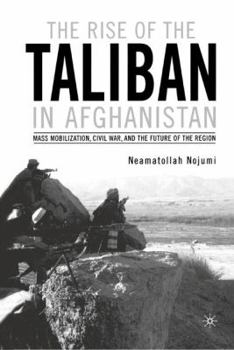The Rise of the Taliban in Afghanistan: Mass Mobilization, Civil War, and the Future of the Region
Select Format
Select Condition 
Book Overview
This book describes the turbulent political history of Afghanistan from the communist upheaval of the 1970s through to the aftermath of the events of 11 September 2001. It reviews the importance of the region to external powers and explains why warfare and instability have been endemic. The author analyses in detail the birth of the Taliban and the bloody rise to power of fanatic Islamists, including Osama bin Laden, in the power vacuum following...
Format:Paperback
Language:English
ISBN:0312295847
ISBN13:9780312295844
Release Date:January 2002
Publisher:Palgrave MacMillan
Length:260 Pages
Weight:0.70 lbs.
Dimensions:0.8" x 6.0" x 9.0"
Customer Reviews
3 ratings
The Rise of the Taliban in Afghanistan: Mass Mobilization, Civil War, and the Future of the Region
Published by Thriftbooks.com User , 18 years ago
Background 1. Title and Subject. The rise of the Taliban in Afghanistan is an illustrated book in which the writer explains how Afghanistan became the base for radical fundamentalism. It also provides a critical understanding of how internal divisions and the devastating effects of foreign interference undermines the resilience of Afghanistan communities, led to the rise of Taliban ultimately present a unique challenge to international efforts to nation building. 2. Author. Neamatollah Nojumi was raised in Afghanistan and also participated in the Mujahideen fight against the Soviet invasion of Afghanistan. He also contributed to humanitarian efforts in providing medical and other related services to those Afghans who have suffered from the external and internal fighting. He is a frequent speaker on the politics of Afghanistan. 3. Thesis The author objective is to inform the instructive analysis to help the readers to fathorn the diverse complexities as well as to provide the critical context to understand the obstacles and opportunities ahead in achieving peace in Afghanistan. Contents 4. The book is basically divided into four main elements, Socio-political differences, Mass Mobilization, Civil War and the future of the region. (a) Socio-Political Differences Neamatollah Nojumi describes about the events of massive political, social and cultural changes as a result of the April 1978 COUP D'ETAT by the People Democratic Party of Afghanistan (PDPA) followed by Soviet invasion in December 1979, lasted for almost ten years. The PDPA attempted to move Afghanistan from a pre-industrial Society to a political establishment for paving the way towards socialism. Since the people in Afghanistan lived, traditionally, under Communal Codes of autonomy and individual freedom, therefore PDPA was unable to foresee the depth of these codes. IT ultimately caused massive violent confrontation between Afghan Communities and the PDPA-led government. (b) Mass Mobilization The writer describes that the mass mobilization is the result of clash between masses and government which occurred as a result of political, social and economic interaction. The Afghan mass mobilization revolves around three groups. The leftist (pro-and anti-Moscow) the radical Islamic political parties (the Ikhwanis and Wahabis) and the nationalist/Islamic political parties. The role of Afghan Mujahideen in the process of Mass Mobilization is very important because of their internal divisions. The political leaders in the PDPA and Mujahideen organization failed to provide a viable solution in the course of decades of war and violence. (c) Civil War Neamatollah Nojumi comments that after the Soviet withdrawal from Afghanistan in 1989, the lack of trust between Mujahideen and government under Najeebullah led to civil war in Afghanistan. The severe confrontation between Iran-based leaders, the Pakistan-based leader and the external front leaders raised the issue of power-sharin
information is a dangerous thing
Published by Thriftbooks.com User , 18 years ago
read this book written by an afghani to get a broader understanding of the region.though this book was published in the mid 90's as you read it you'll not be sure if you're reading on afghan. during the 80's or iraq under US occupation today.
Good overview of the rise of forces leading to Bin Laden.
Published by Thriftbooks.com User , 20 years ago
This slim volume gives a theory, which ultimately let the likes of Osama/Usama Bin Laden, and the leadership of the Taliban, take over in Afghanistan, and their relationship to the 11 September, 2001 (9/11) attacks and the aftermath (in the Epilogue). Gives a theory of mass revolt + mass participation + mass organisation (organization) = mass mobilisation (mobilization) in which the author provides a framework for groups, like Al-Qaeda, operate. Further, the book gives a historical perspective on how the competition between "secular" and "religious" forces have shaped the rise of groups, like Al-Qaeda and the Taliban, in Afghanistan. The author proffers a theory to limit the effects of terrorism, and the increasing numbers of disaffected Afghans, for example, or as in Iraq, Iraqis; who join militant Islamic groups, due to a lack of stabilisation (stabilization) in the country, to provide for a stabilised [stabilized] country and to work to support a more stable government, in particular, the United States in its foreign policy and not just to (as in Iraq) "bomb the people into submission" (n)or "to support a 'puppet' regime, either of which leads to the sort of militancy which the U.S. forces are now facing in Afghanistan and in Iraq [as part of a failed foreign policy, continuing through many administrations; especially the (newly)"reelected" one in the U.S.]. Worth a look.






